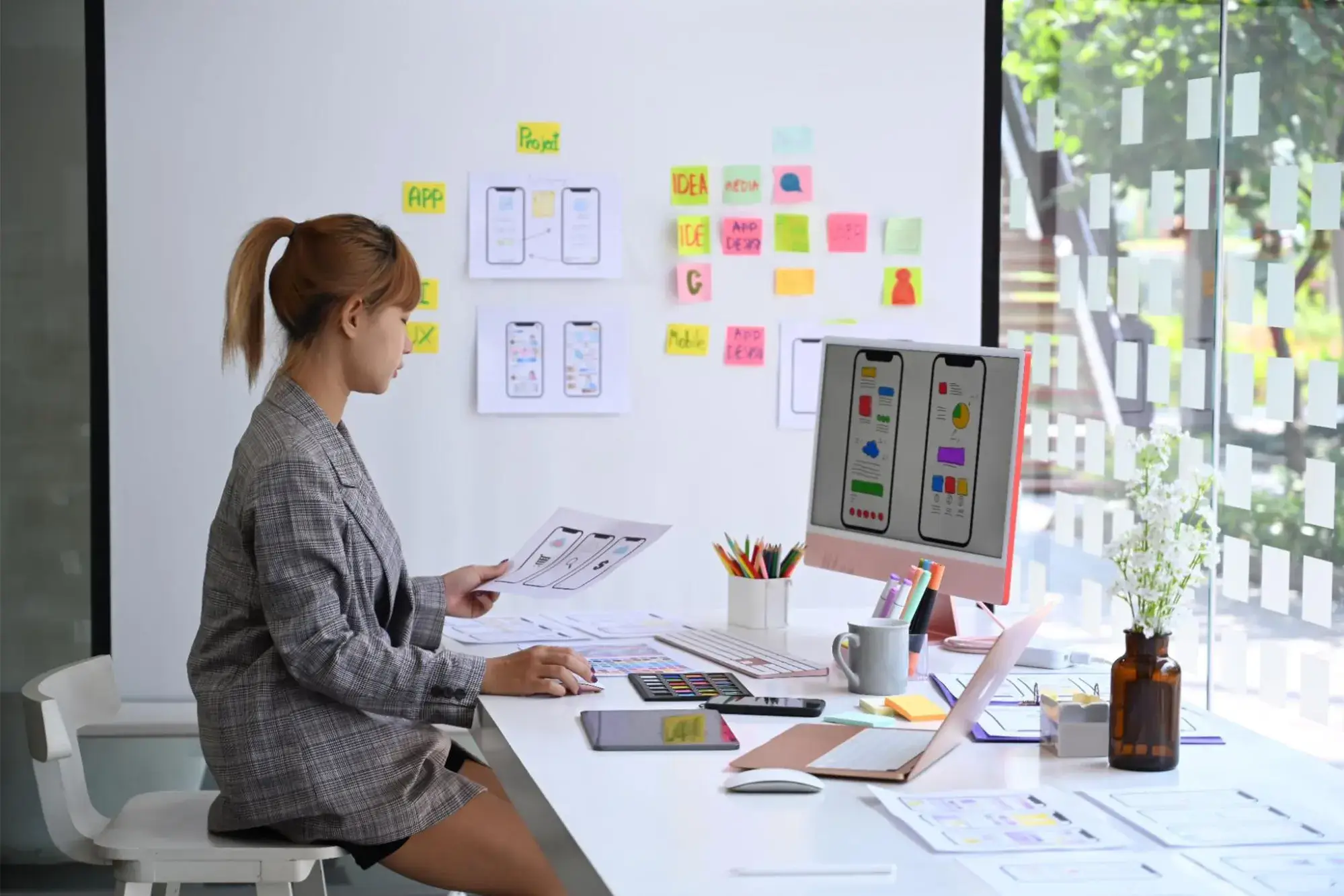Want to learn how to create a UI designer resume that leaves you standing out from the crowd? We’ve got all the steps you need to take in this complete guide.
If you’re a UI designer who’s looking to land a new role in the field but need some help putting together a stand-out resume, then you’re in the right place. In this article, we take you step by step through what you need to do to ensure you build a resume that gets the attention it deserves from employers and recruiters.
From what to include in your summary statement to how to incorporate your UI design portfolio, we’ve got you covered. By the end, you’ll have a UI designer resume that not only reflects your unique talents and experience but is also a resume you can be truly proud of.
Contents:
- How to craft the perfect UI designer resume
- Which format should I use for my UI designer resume?
- How do I customize a resume to my level of experience?
- How do I showcase my UI designer portfolio within a resume?
- UI designer resume tips
- Conclusion
Ready to start working on your resume? Then let’s get started!
Steps to crafting the perfect UI designer resume
We’ve got all the steps you need to craft the perfect UI designer resume. Let’s dive straight into the details of each.
1. Write an objective or summary statement
The first step in crafting a UI designer resume that will enable you to land your dream role is to write an objective or summary statement. This impactful, yet concise, paragraph of text at the top of your resume should seek to make a positive first impression on employers and highlight your expertise, passion, and the unique qualities you believe you can bring to an organization in a UI designer role. You should aim to convey your experience in the field, your abilities with the latest tools and methodologies, and your commitment to building user-centric digital interfaces that optimize the user experience overall.
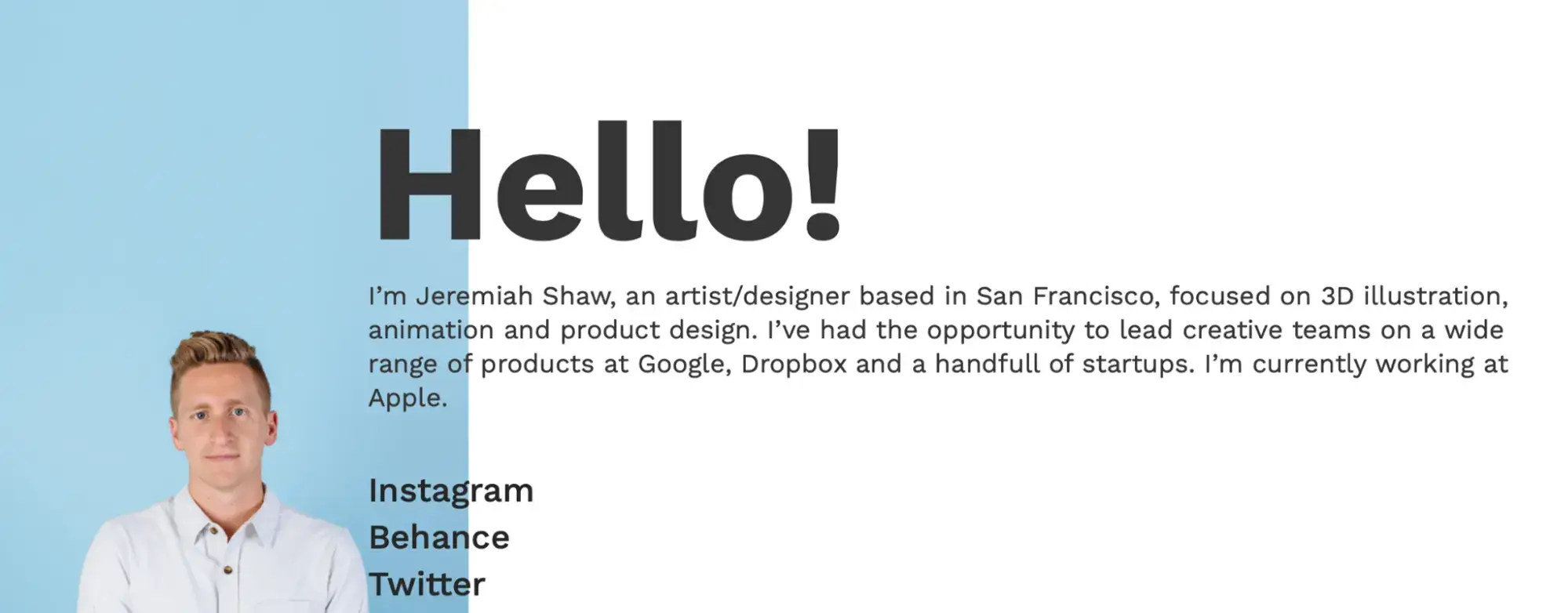
Example of a summary statement from Jeremiah Shaw’s portfolio website.
2. Include a skills section
Demonstrating your hard and soft skills is crucial to optimizing your UI designer resume as it draws an employer’s attention to what you can tangibly offer them and enables them to quickly assess your suitability for the role being offered. With this in mind, consider this section a snapshot of what you are capable of, highlighting both your technical capabilities and your core interpersonal, administrative, and psychosocial skills that set you apart from other job candidates.
This is also a good place to include your expertise with different digital tools such as Sketch, Adobe XD, and Figma, as well as your familiarity with a range of UI design skills and methodologies such as wireframing and usability testing. In terms of soft skills, employers will be keen to see candidates who have strong problem-solving and creative thinking skills, in addition to robust collaboration, communication, and creative skills that will support a design team.

Example of a skills (and tools) section from designer Jeremy Hickman’s portfolio website

3. Include your contact information
Including your contact information in a clear and accessible way is an absolute must to ensure you don’t miss out on potential opportunities or leave recruiters or employers feeling frustrated. Be sure to include your full name, professional email address (if it’s not professional-sounding, create a new one which is) and your mobile phone number and position them in a central place on your UI designer resume, such as at the top-right under your name.
While it’s not essential to include anything else, if you have a LinkedIn profile, a Behance profile, or an Instagram account where you showcase your projects, include them here too as these will provide employers with additional insights into your experience, qualifications, work, and style. Remember, the more prominently displayed and accessible your contact information is, the easier it is for recruiters to get in touch with you, so prioritize clarity and visibility here.
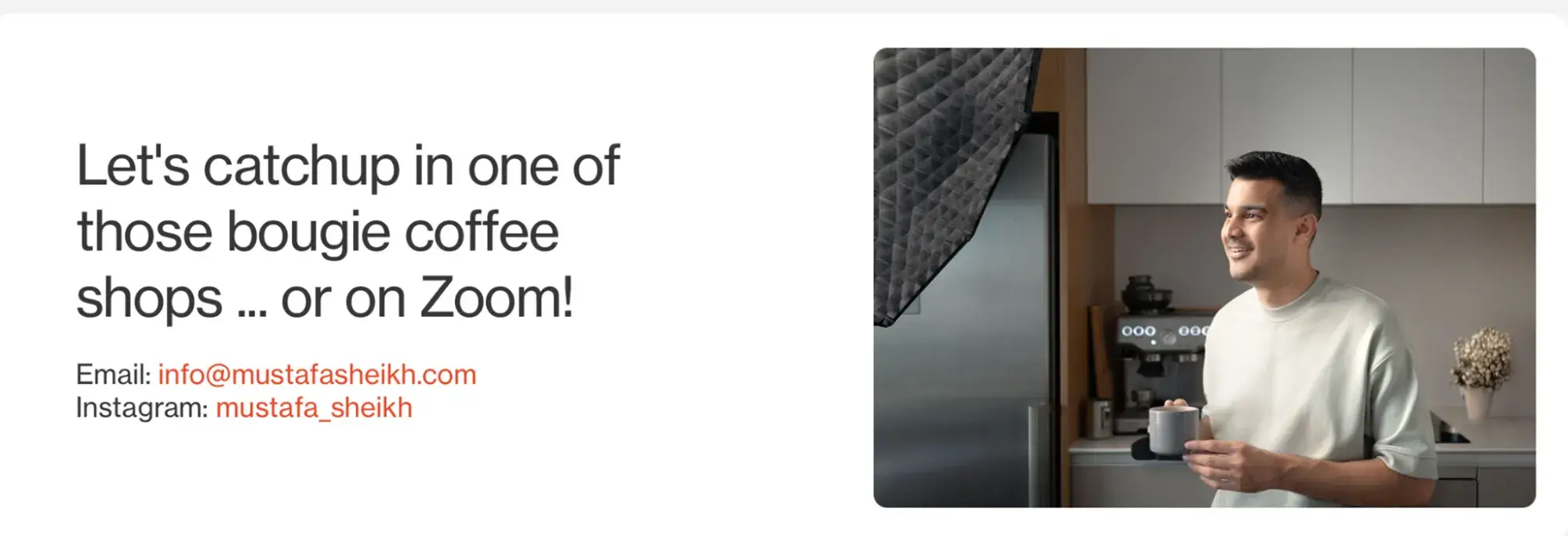
Contact information section example from designer Mustafah Sheikh
4. Add in professional experience
Your professional experience is the cornerstone of your UI designer resume. Most designers choose to format this important career journey information in chronological order, highlighting the roles, companies, and achievements that have contributed to their professional experience. It can be useful to display this information by starting with your most recent role and working backward, as an employer will be most interested in the position you are directly coming from, rather than the one you started out with when you first got into the industry.
Here’s a rundown of what to include for each position:
- Your job title
- The company you worked for
- The team you worked on
- The dates when you started and finished at the company
- Key projects
- Teams you collaborated with
- Your main responsibilities
- Any key achievements or awards received
Rather than detailing every task and activity you did in each position, try instead to focus on the value you brought to each role- how you developed, what you learned, and what you contributed to the company overall. You could also mention key clients you worked with or any accolades you received.
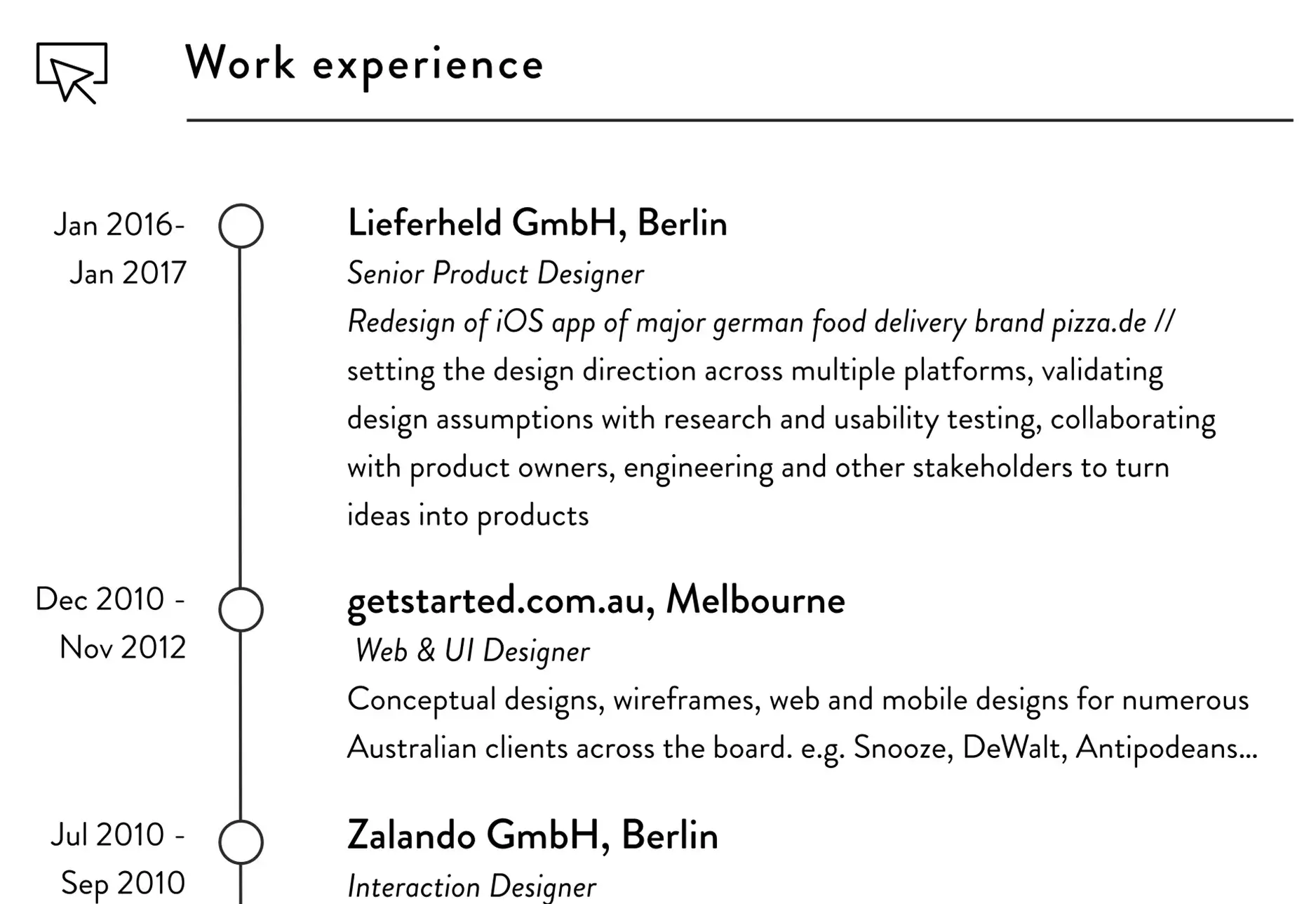
Work experience section from the resume of designer Anida Granilo.
5. Include a portfolio section
A portfolio section is a crucial part of a UI designer’s resume. It’s an opportunity to showcase your work, skills, process, and design proficiency. You’ll want to highlight your best work here as well as your versatility and creativity, so consider showcasing a diverse range of projects that draw attention to your strengths. While high-quality images of your work will make up the focal point of your portfolio section, it’s important to include annotations and descriptions detailing each project, the team’s objectivity, your role and responsibilities, and any tools used. An employer will also be interested in seeing how successful the design was, its impact, and how you overcame specific challenges.
Even though it’s possible to include a small portfolio section on the resume itself, many designers choose to share a link to an online professional portfolio that encompasses all of the information and images we have discussed here but in greater detail. This enables employers to browse leisurely through projects and get a real sense of the UI designer’s work ethic, experience, style, and creativity.
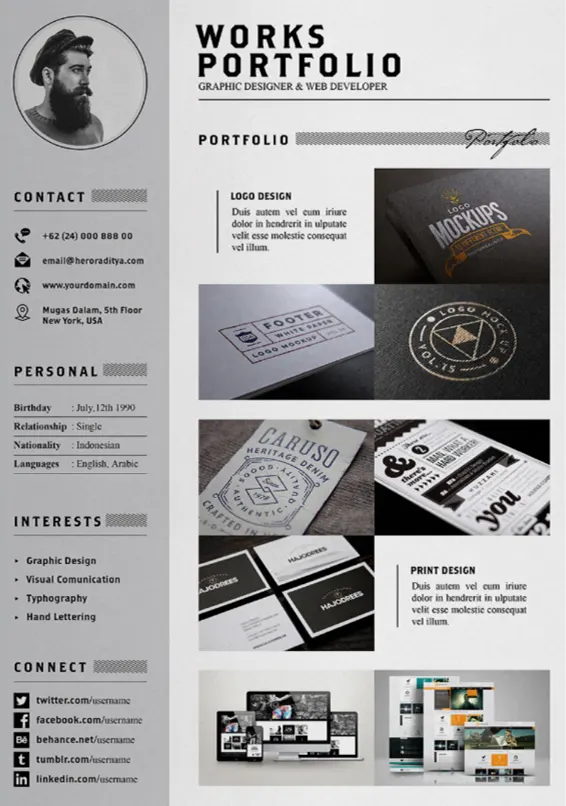
An example of a portfolio section included on a resume.
6. Include your education and certifications
In order to communicate your formal design background to employers and recruiters, you’ll need to state your certification and education clearly on your resume. Whether you’ve taken a degree course or a bootcamp to learn your trade, include the name of the institution and the type of course, and highlight any particularly relevant modules. Also, don’t forget to mention the grade you came away with and any certification you were awarded. This information is valuable to employers who need to know you have the foundational knowledge needed to take on a role and makes them aware of any areas where training might still be necessary.
Don’t be afraid to include all design-related courses in this section (or even courses from other fields that support UI design such as marketing or psychology) as these also demonstrate your commitment to education and professional development.
7. Outline the tools you are familiar with
Employers will be keen to know which design tools you’re adept at using so they can get an idea of your level of experience and how well you will be able to work with their preferred technology and systems. For this reason, be sure to outline the UI design tools you’ve been using on projects and indicate your level of proficiency with each. If you’ve taken a course to improve your skills with a particular tool, be sure to include it too.
It’s important that you don’t limit your tool list to just design tools either; include communication tools, organizational tools, and documentation tools to enable employers to see if you need any additional training in order to fit in with the current team.
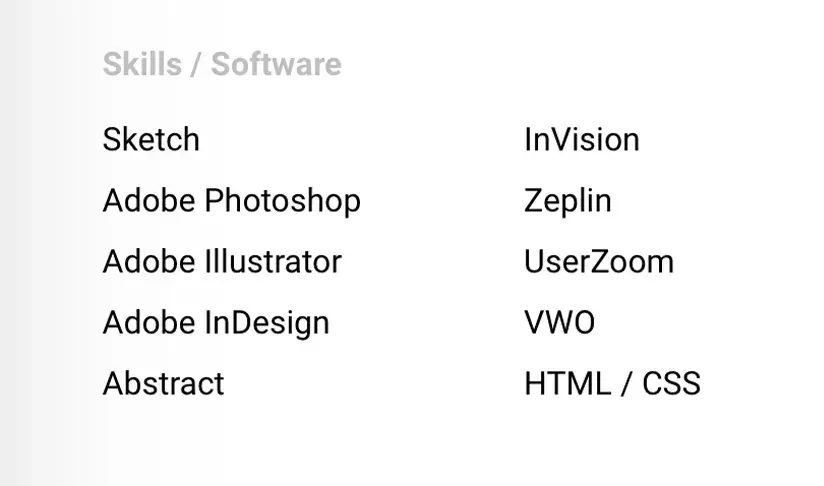
The tools section from designer Scott Penhaligan’s portfolio website.
Which format should I use for my UI designer resume?
When deciding on the best format to display the information on your UI designer resume, it’s advisable to treat it like a design interface. This means ensuring clarity, readability, and navigation in addition to prioritizing the details that an employer will be most interested in over the less important extras. Stick to a clean, well-organized layout, emphasizing a visual hierarchy that enables you to highlight your key skills and projects prominently on the page.
There are three popular formats that UI designers commonly opt for when deciding on the best formatting for their resumes.
Reverse Chronological refers to when an individual lists their work experience beginning with their most recent position and working backward in time. For each job listing, the UI designer includes their job title, company name, location and dates of employment before a short list of bullet points highlighting key responsibilities and achievements. This is a good option as it’s easy for employers to follow and it clearly showcases career progression.
The second popular UI designer resume format is known as Functional. This formatting style refers to when a designer positions elements on the resume to focus on their skills, competencies, and achievements rather than a chronological work history. This type of resume usually includes a more comprehensive skills section where abilities are categorized into groups. A Functional resume style is a particularly good option for those who have gaps in their employment history or who are changing careers as it focuses on what the individual can do rather than when or where specific experience was acquired.
Finally, a Hybrid-style UI designer resume format is a combination of the Functional and Reverse Chronological resume formatting styles. The benefit of this style is that it allows you to highlight your skills while also providing a detailed work history for potential employers. This format usually consists of a header and contact information, a summary statement, a detailed skills section, a chronological work experience section, and finally a section dedicated to education and certification. This formatting style is a good option for those with a diverse range of experiences or those looking to transfer from one field to another.
How do I customize the resume to my level of experience?
In order for an employer or recruiter to gain a good sense of your level of experience through the information communicated on your resume, you’ll need to tailor the content to specifically highlight your skills, education, and achievements.
To do this, an entry-level UI designer should draw attention to any training programs, educational courses, internships, voluntary work, or freelance projects that effectively demonstrate their foundational knowledge and skills as well as their commitment to this career path and desire to learn.
A mid-level UI designer should focus on the projects, roles, and accomplishments they are most proud of, particularly those that showcase their growing expertise, responsibilities, and any additional training they’ve taken on to build on their skills and advance their careers.
Finally, senior UI designers will be expected to focus on their leadership qualities, strategic planning skills, impactful projects, and any industry recognition they have acquired. Irrespective of your level of experience, it’s good advice to try where possible to demonstrate how your background and experience make you the right person for the role being advertised.

How do I showcase my UI designer portfolio within a resume?
You have a couple of options open to you when it comes to showcasing your portfolio within your resume. Some designers choose to include a dedicated section within the resume that briefly covers key projects, while others choose to place a link to their online portfolio in a prominent position on their resume that takes the employer to a professional portfolio website.
While the first option means that employers get to see the work immediately without leaving the resume, the second option offers a UI designer more space to elaborate on their work and process. A third option is a combination of the two: providing some key project images in a dedicated space on the resume and also linking to a professional online portfolio that offers more images and information.
Tips for your UI Designer resume
Here is some final resume advice to help you get noticed by recruiters and employers.
1. Highlight your skills and experience
Try to ensure that your skills and relevant experience are the first thing an employer sees when they receive your resume. Placing this information prominently somewhere close to the top of the page is always a good idea so your level of expertise is available at first glance.
2. Tailor your resume to the job you’re applying for
Although it can be tempting to copy and paste the same information for every job you’re applying for, you’ll stand a much greater chance of landing an interview if you tailor your resume to each job description. Make a list of keywords that the job listing has used, particularly in terms of skills, tools, and experience, and see where you can match these requirements on your resume and highlight them. Try to demonstrate why you’d be the perfect fit for that particular role and you’ll quickly stand apart from other candidates.
3. Showcase teamwork and collaboration
An employer will be particularly keen to see how well you work with others as designers need to work closely with both design colleagues and multiple other teams. For this reason, highlighting any collaborative projects or teamwork on your resume will improve your chances of being selected for an interview. You can take inspiration from this UI Design Project by AND learner Abhishek Singh to even create an independent design portfolio for best results.
4. List programming languages or skills that complement your design expertise
While not every designer is proficient in programming, those who are should consider making a mention of the same. If you do have expertise in programming languages or any other specific technical skills that complement your design skill set, don’t be shy about mentioning them on your resume. A designer who understands how websites are built (and not just designed) is an asset to any design team.
Conclusion
We hope you’ve found our step-by-step guide to UI designer resumes helpful in crafting your own resume and that our tips and advice lead you to landing a new UI design position. Be sure to focus on your unique strengths and abilities, showcase your achievements and learnings, and remember to demonstrate both your commitment to this career choice and your passion for the field overall.
If you’d like to read more about careers in UI design, head back to the AND Academy blog for more articles like this one.
Next Steps:
Here are some additional resources you might find useful:
- Watch this session by Shiva Viswanathan, Design Head of Ogilvy Pennywise, and Naman Singh, Product Experience Designer at RED.
- Talk to a course advisor to discuss how you can transform your career with one of our courses.
- Pursue our UX UI Design courses – all courses are taught through live, interactive classes by industry experts, and some even offer a Job Guarantee.
- Take advantage of the scholarship and funding options that come with our courses to overcome any financial hurdle on the path of your career transformation.
Note: All information and/or data from external sources is believed to be accurate as of the date of publication.

